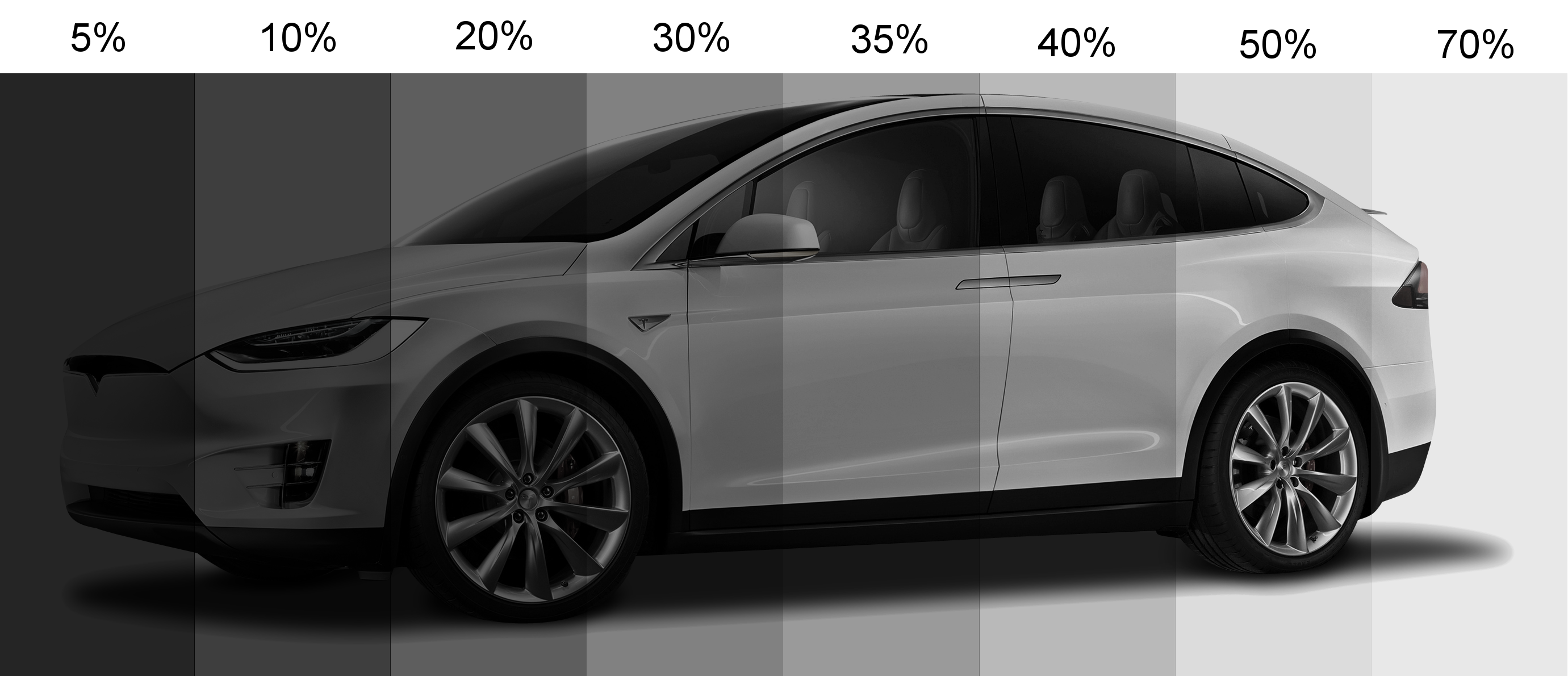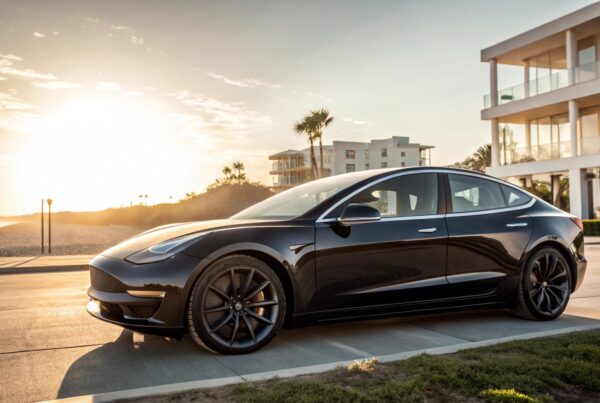An Introduction to Car Tint for Windows
Keeping the interior of your car cool during hot summer months is a challenge. Whether you live in the Phoenix Valley, Las Vegas, or deal with added humidity in the Mid-Western and Eastern US, the constant bombardment of UV rays amplified via glass can create a sauna effect. One way that vehicle owners combat this issue is by having professional detailers apply car tint for windows.
Window tinting for cars comes in a variety of materials, shades, and with unique attributes. There are car tints that are transparent, some designed for visual enhancement, and others that provide infrared protection with superior clarity. But with so many different types, materials, and brands of tinting for cars on the market, it’s not a shock to learn that many of us car owners simply don’t have all the facts.
That’s what we’ll endeavor to provide you today. In the information below, we’ll provide a detailed overview of window tint film. We’ll introduce the different types of tints, how they are made, the application techniques, how long they last, and some tips for determining which tint is best for your individual application.
What are the Types of Tinting for Car Windows?
Did you know that there are more than 1,000 individual blends of window tints for cars on the market today? As there are so many options, choosing the right tint film is usually a time consuming and frustrating process. That said, there are generally six different types of tinting for car windows. With each grade or type of tinting comes different benefits and price-points.

Dyed Window Tint
For those looking for the entry point of tint film, the dyed variants provide an affordable option. The main attribute of this tint is to block sunlight via multiple layers of infused dyes, that absorb solar heat and reduces the potential of increasing cabin temperature. However, it doesn’t really provide protection against UV exposure. It’s available in multiple opacity levels which makes it more of a visual enhancement window tinting.
Metalized Window Tint
The second level of car window tint is the metalized materials. Instead of using dyes the film is infused with small particles of metals to block the sunlight. A metalized tint produces a rather rich shine or luster, but also provides added strength to the window – which reduces the potential of windows shattering.
A metalized film provides several benefits including:
- It’s effective at blocking heat from entering the cabin.
- It is an effective glare reduction tint.
- It is effective at blocking UV rays, but not the best option available.
The Hybrid Dye and Metallic Tint Film
If you’re looking for the best of both tints above, the hybrid tint is a good option. This type of window tint is typically comprised of a grey dye and titanium metallic flakes. It’s not too dark, nor reflective, which makes it good for blocking UV rays, reducing sun exposure inside, while providing a mid-level tint film that doesn’t negatively impact night driving.
Carbon Tint Film
While the three above are considered ‘entry level’ – the carbon infused window tint is elevated. This is where the tinting health benefits start to come into play, by creating a comfortable cabin experience. It’s a matte finish that helps to block nearly 40 percent of infrared radiation – which is the main contributor to increasing internal cabin temperature. It’s also good at blocking UV exposure – which is what leads to fading and aging of interior materials like plastic trims, leather seats, and dashboards.
Another positive attribute of the carbon tint film is that it does not fade like those mentioned above. As such, it tends to last longer, and hold up for several years. The trade-off of course is an elevated price-point.
Crystalline Window Tint
There are several car owners that prefer the cooling and protective attributes of car window tinting, but without the darkening affects. This is possible by choosing a crystalline window tint. It’s designed to block UV radiation and infrared radiation – which keeps the inside of your vehicle cool, reduces the potential of extended wear and tear – without the darkness.
Ceramic Window Tint
On top of the window tint Mt Everest is a ceramic infused film. This is literally the best of all worlds – as it’s developed using small ceramic-based particles that are highly nonconductive. This means that it does not reduce electronic transmissions from cell phones, Wi-Fi, Bluetooth® or other communication devices.
The ceramic window tints also can block up to 50 percent of solar heat, without any reduction in visibility. They produce exceptional shatter resistance, reduced glare or fading, and effectively blocks 99.9 percent of UV exposure. Ceramic window tint is quite different than ceramic coatings, but we’ll explore that in a future article.
Within all these types of window tints come multiple shades or darkness of the tint. We’ll discuss the legality of these tint percentages below.
What Kinds of Car Window Tints are Legal?
In the United States and Canada, car window tinting laws are based on the individual state or providence. As such, there is no centralized window tint rule for legality across the entire country. The American Automobile Association or AAA has a detailed list of window tint regulations based on each US state and Canadian providence.
You can review the specific regulations by clicking this link.
Window Tint Definitions for Legality
When you review that detailed list posted by our friends at AAA, you’ll notice several terms which describe specific attributes of the window tint. Some of these terms are a bit confusing and technical. So, here is an easier to understand listing of the technical language you’ll find.
Tint Darkness: The darkness of window tint is measures by the visible light transmission percentage. This is often abbreviated as VLT%.
Front Side Windows: When a regulation talks about the front side window, they are referring to the two windows directly next to the driver and passenger seats. In a sedan, this would include the front doors, while a coupe would include the only two doors on the vehicle.
Rear Side Windows: The side windows or rear side windows will refer to windows that are behind the driver and passenger seat. For multiple row vehicles such as SUVs, this will include any windows on doors behind the front or solid windows molded into the body. There are also regulations for rear window installations, but they are usually not as stringent as other vehicle window locations.
Window Shade Band: The front windshield may receive a window shade band, which is applied to the top section of the windshield. The size of this film and the tint darkness percentage will vary based on individual states and providences.
AS1 line: Each glass manufacturer includes an AS1 marking near the top left or right side of the windshield. This certifies that the tinted window complies with US or Canadian Department of Transportation regulations. In most cases, the AS1 line can’t be blocked.
Tint Reflection: As we mentioned above, some window films such as metallic window tint has a reflective quality.
The / Symbol: Typically – state regulations will document different factory tint percentages and other criteria based on the type of vehicle. If you see different tint legal numbers or percentages that are separated by a “/” symbol, it will separate two types of vehicles. The first number will indicate ‘cars’ including a coupe or sedan, while the number after the / symbol will be specific for SUVs or multiple passenger vans.
Which Types of Car Window Tints are Most Popular?
There are two paths you can travel when choosing any window tint for cars. The first option and most popular is having a professional auto salon complete the tint service. The professional shop will handle all the prep work, custom fit the window tint, apply it, and in some cases, offer a warranty for the longevity.
Several tinting shops can also complete paint protection, services like applying paint protection film, and ceramic coatings, so you can honestly have everything done to your new car at the same time.
The other option is the do-it-yourself method. This is becoming increasingly popular with DIY enthusiasts, as technology has made it easier for the average detailer to purchase pre-cut window film and apply it themselves. Most of these DIY window tint film products are intended to block harmful UV rays vs blocking IR. UV protection is an important attribute that any window tint film should possess.
That’ll be the first decision you make – as DIY car window tint options are limited. It’s similar with the DIY ceramic coating world. DIY window tint film is designed for easier installation as opposed to advanced protective qualities. This limits your options considerably.
With professional installations, the sky is virtually the limit – as are the tinting benefits. A growing trend in professional tinting are those infused with ceramic substances. This helps to block UV and IR – keeping the interior of the vehicle cooler for longer periods. They are also available in multiple tint percentages.
How Do You Know Which Type of Window Tint is Right for Your Car?
If you’re thinking about installing a new tint film, you’ll have to make a few important decisions before pulling the trigger. A few of the important questions you need to ask to determine which window tint is right for your car include:
What is most important? Different tints offer individual attributes. Some – like the entry level dye window tint are mainly aesthetic – to make the windows appear darker on the outside. There are ceramic tinting products that give you the best of all worlds. So, before you decide which tinting is best – write down what attributes are important to your specific application.
What is your budget? Obviously, the cost of the window tint and installation is another important factor to determine. The problem is – determining the cost of window tint is based on several variables including:
The type of tint: The main factor that determines the price of window tint is the installation. The cost for material itself is inexpensive. This is what often teases many car owners to attempt the DIY route. However, usually mistakes are made, and reordering new material, paying for more shipping, and the time to clean up adhesive just makes it impractical.
Lower grade window tint (such as the dye window tint) will be cheaper (not only in quality but in price), while the advanced ceramic or carbon-based window tints will have a premium price. It’s similar with comparing ceramic coatings. Spray on hybrids are cheaper than longer-lasting 9H ceramic coatings.
The cost of labor: The second element that impacts your budget is the cost of labor. However, not all window tints are applied the same. Some will take more time, and thus – have an increased labor cost. The good news is that professional auto salons will simplify the estimate process for you by providing a flat rate for the entire job.
How long are you keeping the vehicle? The final question you’ll ask before choosing a window tint for cars is how long you plan on keeping the vehicle. It makes sense that you’d want to purchase a window tint that will last as you own your ride.
How Many Years does a Car Window Tint Last?
Most window tints have a life expectancy from 3 to 5 years. However, there are new window tints entering the market in 2020 that can hold up even longer. There are several variables that will impact the longevity of car window tint which can affect car’s resale value including:
- The quality of the tint: Not all window tint is equally made. Window tint is no different than any other car care product, as some manufacturers put more effort, engineering, and technology to come up with a finished product. In general, the quality of window tint is based on the type of tint (as explained in the first section), the adhesive bond (which helps it stick to the glass), and the application technique.
- The exposure to direct sunlight: Window tints main task is to block UV or IR from entering the vehicle. However, it has its limits as to how much it can absorb. If a vehicle is parked outside frequently, it can prematurely wear the window tint. This is especially true in hot climate regions.
- The application: While it’s lower on this list, the application of the window tint is arguably the most important factor for longevity. Professional detailers and auto salons are trained on installation techniques for the specific window tints they sell to customers. They take time to ensure the correct prep work has been completed, ensure the tint is correctly bonded, and has cured prior to releasing to the car owner.
To get the most out of your window tint, always defer to a professional installer.
How Tints are Applied to a Car Window
The window tint application process basically breaks down to a four-step process for the professional auto salon. If you’re looking for tips on how to install a DIY window tint, it’s always best to refer to the specific instructions provided by the manufacturer. For those who’d like a general understanding on how window tint is applied, this video on window tint installation will provide some great information.
Step 1 – Prep Work
As the saying goes – prep work makes the dream work. This is especially important when applying a new window film tint to your car, truck, or SUV. Once you pick the type of window tint, the tint percentage, and other custom factors, the installer will begin the process by prepping the windows that will be applied.
Prep work is always customized by the auto salon completing the tint installation based on a few variables. First, the condition of the existing window. If you have a new car – direct from the factory, the amount of grime or other cleaners / treatments is going to be less severe than an older vehicle. If you have a car with an existing window tint, it will have to be removed – which can be tricky.
The main objective with prep work is to ensure the installer has a perfectly clean canvass to work with. They use special cleaners and prep solutions to ensure there is no oil, grease, or film left on the window prior to application.
Step 2 – Measuring and Fitting
The second step is to measure the window receiving the tint and fitting it for a seamless installation. Most professional tint installers will complete most of the measuring, fitting, and final cutting on the outside of the window.
The process within this step will vary based on the exact type of window tint you’re purchasing. Some are pre-cut based on manufacturer’s specs, others must be custom measured, fitted, and cut by hand. There isn’t a benefit either way – especially if you’re having a certified window tint installer complete the service.
Step 3 – Application
Again, this step will vary based on the specific tint material, and the techniques recommended by the tint manufacturer. Typically, the installation or application of the window tint on the inside is the quickest part of the overall tint job – as measuring, fitting, and cutting tends to take the most time.
The window tint is always applied on the inside of the window, so several variables including the access to the windows, how much fabrication (or removing trims pieces and such) is needed, and simple ‘moving around space’ can extend the time for installation.
Professional auto salons will provide a transparent estimate based on your specific vehicle, the amount of windows you want to tint, and any other expenses associated.
Step 4 – Curing & Clean Up
Before your car is handed over, the professional detailer will take the time to ensure everything is cleaned, the window film has cured, and you’re aware of any post purchase restrictions. Most window tints require the car owner to not roll down windows for a day or two, to ensure the adhesive has dried and fully bonded to the window.
Wrapping Things Up
As you can clearly see – there is a lot of information to take in when you’re looking for the best window tint for your car. The best advice we can offer is to always seek out the advice of a professional auto salon that offers window tinting services near you. They’ll be happy to lay out all the pros and cons, explain different window tint benefits and costs, and help you make a decision that is perfect for your budget and needs.
If you’d like to find a window tint installer near you, and request a free consultation, click the button below to begin the process.








